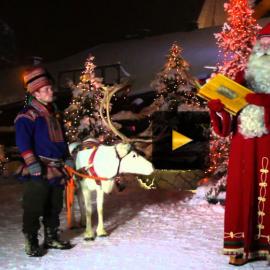Rovaniemi, a city of nearly 61,000 that straddles the Arctic Circle in northern Finland, markets itself as “the Official Hometown of Santa Claus.” Here visitors can meet Santa and his elves, take a reindeer sleigh ride through the snowy landscape, and buy local products.
But Santa’s Village isn’t all fun and games. The site has been the subject of many protests by Sami, the Indigenous peoples of northern Scandinavia, who claim that their culture is being appropriated by the Finnish tourism industry for its own gain. A number of complaints have been directed at Santa and his elves: elements of Sami dress are inappropriately incorporated into the uniforms of non-Sami employees or “elves”; items sold as genuine Sami handicrafts are often cheap imitations made by non-Sami; the Sami are depicted in gift shop merchandise as drunken fools (highly offensive playing cards show the Sami as both the King and Joker characters); and finally, an “Arctic Circle-crossing ceremony” is marketed to tourists as an ancient “Lappish” tradition, but in reality has no precedents in Sami culture.
Over two days in December of 1996, Sami from the three Scandinavian nations protested the commercialization and exploitation of their culture by the Finnish tourist industry. A traditional Sami camp was built in the city for tourists to see real Sami culture. Over 50 protesters, many of them from the Sami youth groups, distributed more than 2,500 English-language brochures to international tourists arriving at the airports and visiting the attractions in Rovaniemi. Souvenir shops and tourists were given pamphlets on how to distinguish a genuine Sami handicraft from imitations.
Three years later, in an update from March 1999, the website for the Finnish Sami youth group (SSN), “Protest against the exploitation of Sami culture”, asked, “Did the protests change anything?!? No, it’s ‘business as usual.’”
As Jeff Taylor, Professor of Media Analysis at the University of Lapland in Rovaniemi, has written: “The derogatory and racist playing cards mocking Sami and the offensive ‘Sami’ dolls are still for sale at Santa Claus Village….The ceremony is still for sale…and as further part of the tourism package, my non-Sami Finnish students working part-time in tourism are still required to dress up as Sami to greet tourists on arrival for their Christmas visit to Lapland and Santa” (pg. 17). The current website for Santa’s Village gives one the impression that very little progress has been made on these issues.
The association made between Santa’s elves and the Sami at Santa’s Village is incredibly belittling—and yet it is merely one of many instances of “othering” that the Sami have had to challenge over the centuries.
And while for many visitors to Santa’s hometown the element of “cultural tourism” is secondary, the increasing use of digital technologies results in a rapid and circuitous misrepresentation. As one TripAdvisor user says: “looking to visit Lapland and want to spend time with the Sami, don’t want to visit Santa, or ski…all I can find involves elves and grottos!?” (source, viewed Oct. 14, 2012). TripAdvisor is just one of many avenues through which the international dialogue on Sami culture takes place. In these types of fora, the cultural “knowledge” obtained from a variety of tourist experiences is modified further through individual bias and opinion. What results is an often selective and distorted image of what constitutes Sami culture, an image that is then further perpetuated through reposting, blogging, and the like.
As the SSN website states in relation to Santa’s Village: “To be the target of ridicule can mean life-long departures from Sami roots—for example in the case of Sami youth at a sensitive age.”
Sami concerns related to the commodification of their culture, including the disproportionate distribution of economic return and the lack of control over cultural representation, are shared by many Indigenous communities dealing with increasing cultural tourism development in their own regions. Though there is no single solution to these issues, many groups, including the Sami, are exploring different approaches to cultural tourism that serve both to educate visitors and to empower the host community.
Further Reading:
George, Jane. 1996. “Sami Youth Protest Exploitation by Tourism Hucksters” Nunatsiaq News.
Hayes, John R. 1997. http://www.thefreelibrary.com/Samis+protest+cultural+violations+in+Scandianvia.-a030356803
Nicholas, George P. and Wylie, Alison. 2013. “‘Do no do unto others…’: Cultural Misrecognition and the Harms of Appropriation in an Open-Source World.” In Appropriating The Past: Philosophical Perspectives on the Practice of Archaeology, edited by Geoffrey Scarre and Robin Coningham, 195-221. Cambridge University Press, New York.
Taylor, Jeff. European Indigenous Internet Representation: Potentials and Perils for Sami. University of Lapland.
The Appropriation (?) of the Month feature, written by IPinCH team members, highlights examples of uses of intellectual property that might be considered appropriations.






